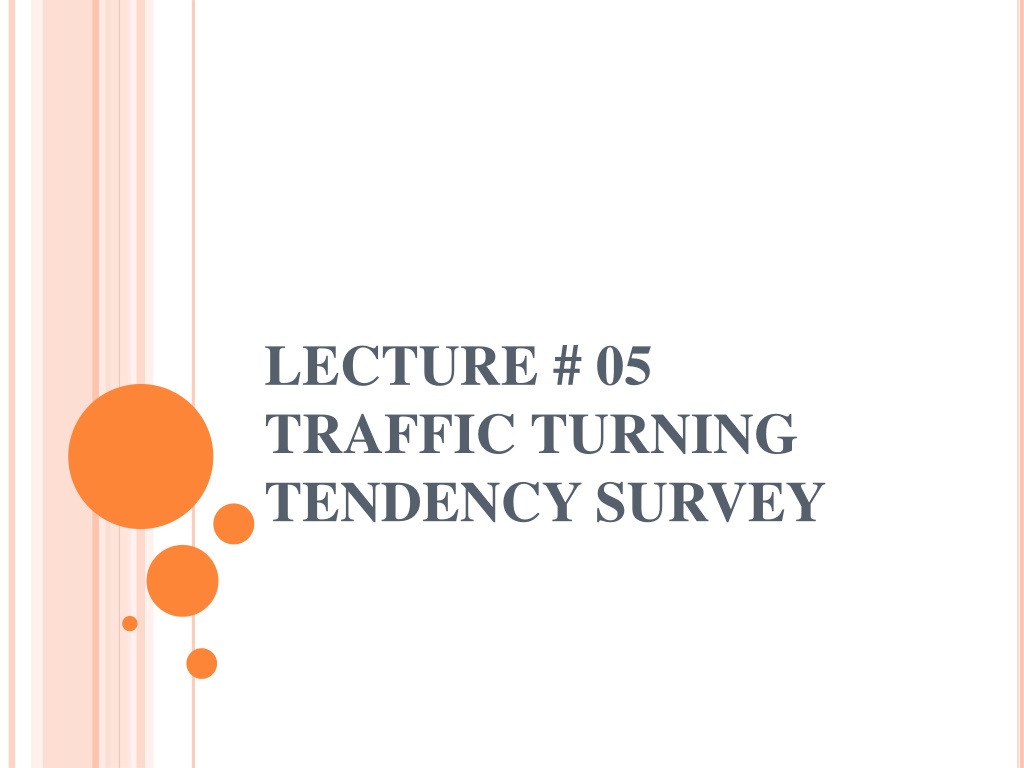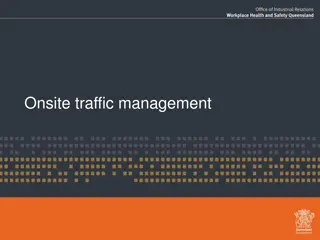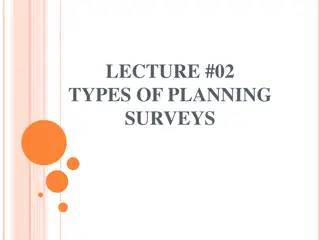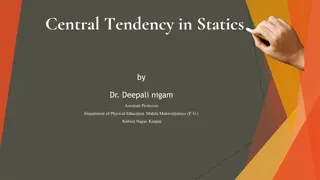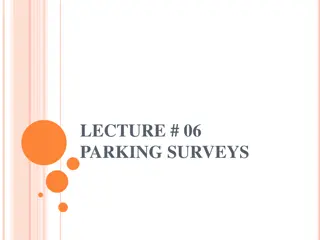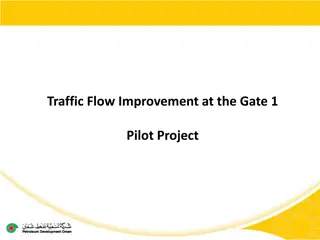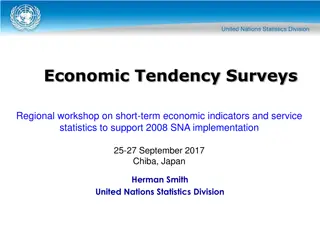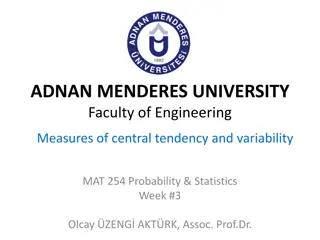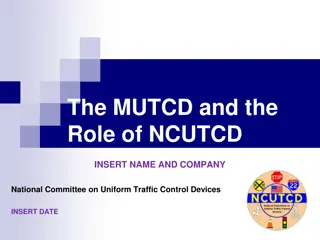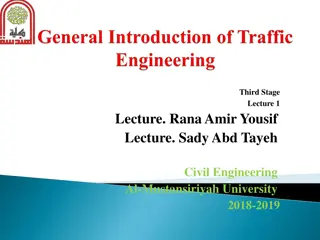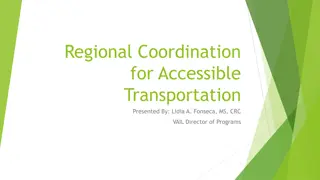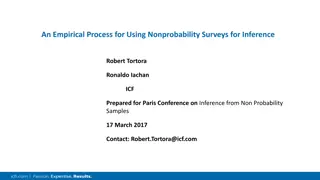Understanding Traffic Turning Tendency Surveys in Transportation Studies
Transportation surveys are crucial for gathering data on traffic movements and factors influencing them. Traffic turning tendency, traffic counts, and flow characteristics help planners assess road efficiency and safety. Monitoring traffic volumes and patterns aids in optimizing road infrastructure and resource allocation for improved transportation services.
Download Presentation

Please find below an Image/Link to download the presentation.
The content on the website is provided AS IS for your information and personal use only. It may not be sold, licensed, or shared on other websites without obtaining consent from the author. Download presentation by click this link. If you encounter any issues during the download, it is possible that the publisher has removed the file from their server.
E N D
Presentation Transcript
LECTURE # 05 TRAFFIC TURNING TENDENCY SURVEY
TRANSPORTATION SURVEYS These are conducted to record existing traffic movements with in the study area and to collect the data about the factors affecting these movements. Transportation surveys include assessment of general traffic characteristics such as existing traffic volumes, parking studies including the provision of both on street parking and off- street parking facilities and public transport facility.
CONT.. Transportation surveys include some basic surveys to get the required information such as Traffic turning tendency Traffic speed Survey Parking Survey Origin and destination Survey Travel Behaviour Survey Pedestrian Survey Noise level survey Trip Generation Survey Air pollution Surveys Household Survey related to transportation.
TRAFFIC TURNING TENDENCY One of the fundamental measures of traffic on a road system is the volume of traffic on the road in a given interval of time. It is also termed as flow and it is expressed in vehicles per hour or vehicles par day. When the traffic is composed of a number of types of vehicles, it is the normal practice to convert the flow into equivalent Passenger Car Unit (PCUs), by using certain equivalency factors. The flow is then expressed as PCUs per hour or PCUs per day.
CONT.. Knowledge of the vehicular volume using a road network is important for understanding the efficiency at which the system works at present and the general quality of service offered to the road users. Knowing the flow characteristic, one can easily determine whether a particular section of the road is handing traffic much above or below its capacity. If the traffic is heavy, the road suffers from congestion with consequent loss in journey speeds. Lower speed causes economic loss to the community due to time lost by the occupants of the vehicles and the higher operational cost of vehicles.
CONT.. Congestion also leads to traffic hazards Volume counts are, therefore, indicators of the need to improve the transport facilities and are a valuable tool in the hands of a transport planner. They enable him to draw up schemes for improvement of roads based on a system of relative priorities and to allocate the scarce economic resources most advantageously. They provide an equitable basis for the selection of pavement, shoulder and bridge widths.
TRAFFIC COUNTS The may be classified into various types such as. Sort-term counts, say, for one hour two hours Counts for a full day Counts for a full week Continuous counts
DATA COLLECTION Before going to the field, the observer should know how the data is going to be used. The following procedure assumes the observer is gathering data to identify the peak-hour traffic volume and how it varies at the peak-hour period.
1. VISIT THE SITE AND CHOOSE A LOCATION AND TIME TO COLLECT THE DATA It is important to visit the site at, or near the time of day when data will be collected. If the purpose is to determine the peak-hour or any other traffic at the intersection, the observer should start at least one hour before the projected peak hour and continue for one hour after the projected peak hour. It is unusual for traffic volumes to be affected by the presence of people counting traffic, so the observer should be placed at such a point that gives a clear view of the intersection and all of its approaches. If video cameras are used, the equipment should be placed where turning vehicles do not block the view of the road.
2. SELECT THE NUMBER OF OBSERVERS REQUIRED FOR THE DATA COLLECTION CAREFULLY. The numbers of observers needed to count the vehicles depends upon the number of lanes in the highway on which the count is to be taken and the type of information desired. It is desirable to record traffic in each direction of travel separately and post separate observers desirable to record traffic in each direction of travel separately and post separate observers for each direction.
3. COLLECTAND RECORD THE DATA Data is observed in fifteen-minute increments throughout the count period usually three hours. Before starting, the times marking the beginning of each fifteen minute observation period are recorded. Then the watch is started, and the volume count beings. During each time period, the approach that each vehicle used to enter the intersection is recorded as well as whether it turned left, right or continued straight when exiting the intersection.
4. CHECK YOUR WORK BEFORE LEAVING THE FIELD Before leaving the field, the data sheets should be checked to see that they are complete. Items such as weather, location, street names, observer names, and the like should be verified. Any unusual observation should be listed as comments. Other than note-taking materials and a watch, no special equipment is required for this survey. A calculator or laptop computer can be programmed to ease the counting task.
DATA ANALYSIS Check the data. Even though the data is checked for completeness prior to leaving the field, it is wise to check each field data sheet again at the office prior to analysis. Summarize the field sheets. The field sheet is summarized on the Turning Movement Counts Summary sheet.
CONT.. Prepare a graphical summary. While a tabular summary is useful, a graphical summary presents information that comprehended. The number of vehicles that were observed executing a particular move appears in the appropriate box. These values are than summed to show the directional volume for each of roadways. A check of the entries can be made by summing all of the values for vehicles entering the intersection and comparing it to the sum of the values for vehicles exiting the intersection. can be more easily
CONT.. Interpret the data and draw conclusions. Interpretation of volume data depends on the use for which the count was conducted. Among the question to be addressed are; Is the traffic evenly distributed among all the approaches to the intersection? Does the peak-hour factor indicate that a rush of traffic is arriving at the intersection during a particular time frame, or is the traffic spread out evenly over the peak hour? Are there heavy turning volumes? At intersections without signals, is the volume of traffic moving through the intersection limited because of delays caused by sign interpretation?
CONT.. While some of these questions may lead to useful conclusions, volume data alone cannot answer all the questions that may arise about an intersection. Additional information such as signal timing, pedestrian flow and volume distribution throughout the remainder of the day may be needed to complete the traffic engineering analysis.
